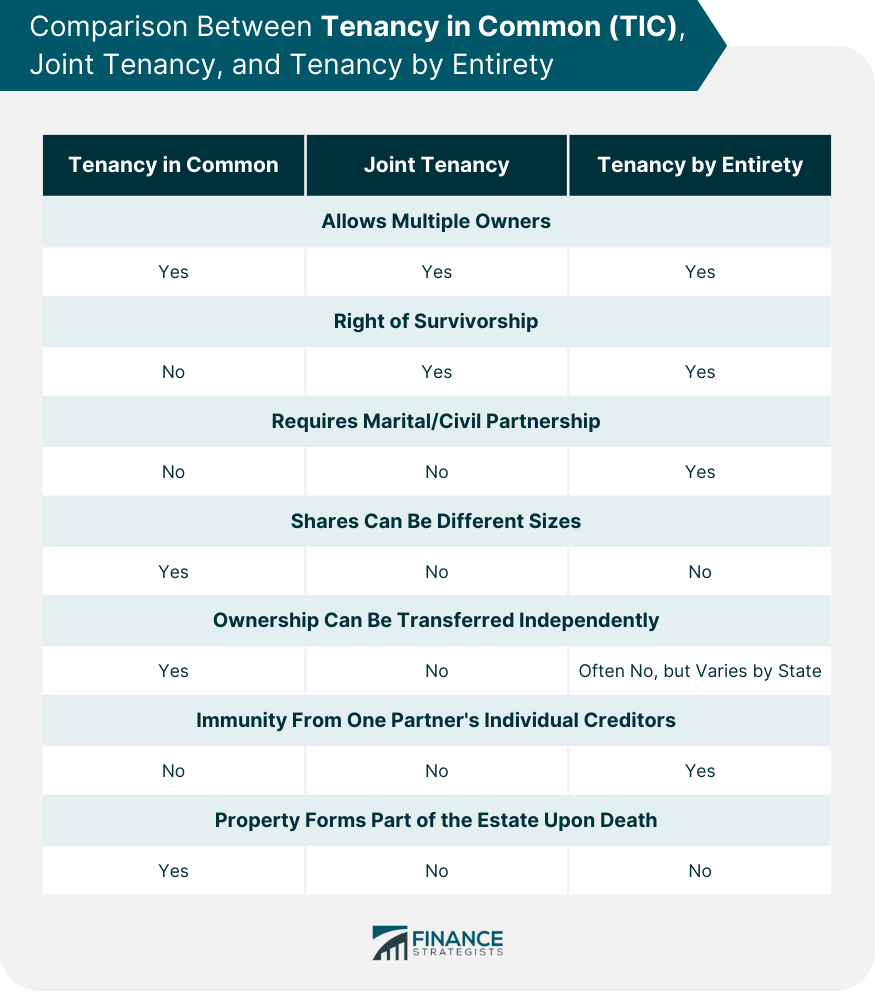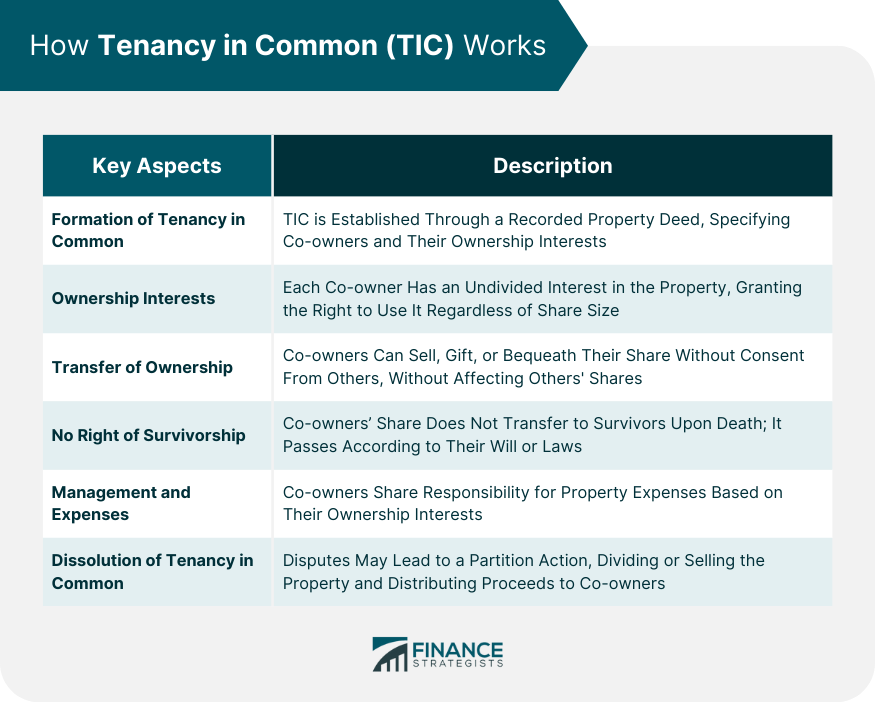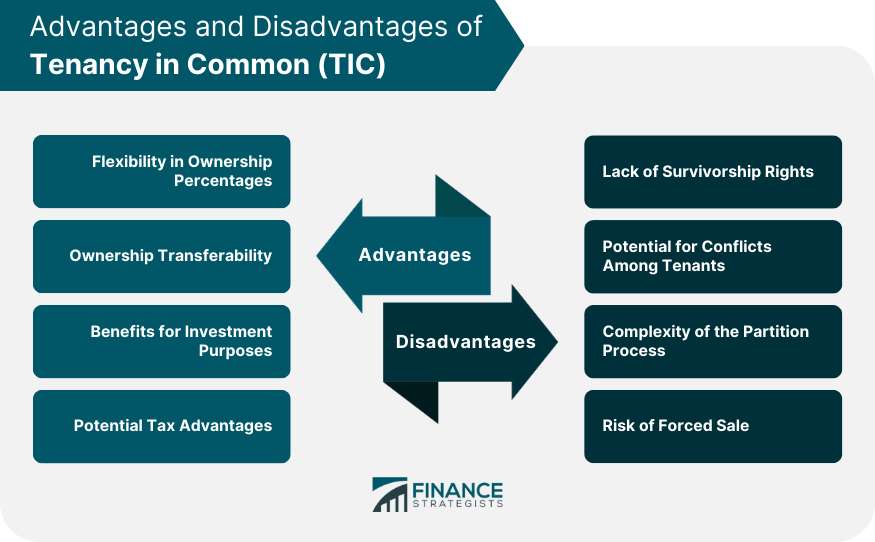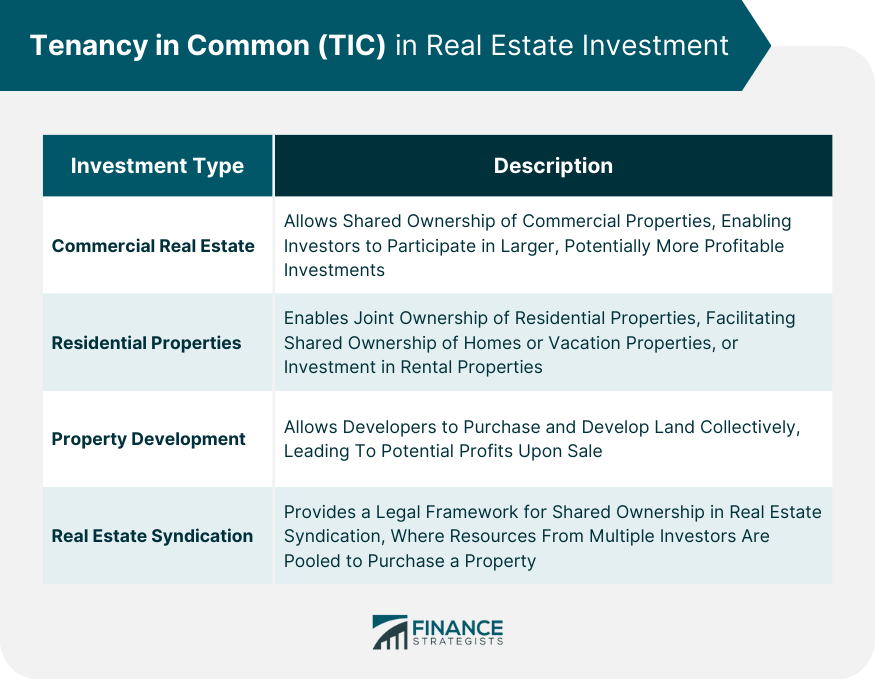Tenancy in Common (TIC) is a specific type of co-ownership of property that grants each tenant or owner an individual, undivided ownership interest in the property. This interest is typically represented as a percentage of the total property. One of the defining characteristics of TIC is the lack of survivorship rights. In contrast to other forms of co-ownership, such as joint tenancy, where the property interest of a deceased owner automatically transfers to the surviving owners, TIC does not offer this feature. Instead, the property interest of a deceased tenant in common becomes part of their estate and is passed on according to their will or state law if no will exists. Shared ownership, as a concept, allows multiple individuals to co-own a property. This method of property ownership is particularly common in real estate transactions and investments. However, the specifics of shared ownership can significantly differ based on whether it is structured as Tenancy in Common, Joint Tenancy, or Tenancy by the Entirety. Joint tenancy is a common form of shared ownership that allows multiple owners to have an interest in a property. What distinguishes joint tenancy from other forms of shared ownership is the principle of the right of survivorship. This principle ensures that if one owner dies, their share is automatically transferred to the surviving owners. This automatic transfer occurs irrespective of any testamentary provision made by the deceased owner. Tenancy by the Entirety is a unique form of joint tenancy exclusively available to married couples or partners in some civil unions. Similar to joint tenancy, it also features the right of survivorship. However, it offers additional protections, such as safeguarding the property from being claimed by one partner's individual creditors. This can prove particularly useful in instances where one partner accumulates significant individual debt. In contrast to joint tenancy and tenancy by the entirety, TIC permits each owner to have a separate, transferable interest in the property. This separate interest can be sold, gifted, or bequeathed to others without the consent of the other owners. A significant distinction of TIC is the absence of the right of survivorship. This means that when a tenant in common dies, their interest in the property does not automatically transfer to the surviving tenants. Instead, their share forms part of their estate and is passed on according to their will or, in the absence of a will, by the laws of intestate succession. It's also important to note that a TIC arrangement does not require the co-owners to be in a marital or civil partnership. This makes it a flexible option for various scenarios, including business partnerships and investment groups. TIC is a type of property ownership where multiple individuals hold interests in the same property. Here's a step-by-step guide explaining how it works: The TIC is usually formed when a property deed is prepared and recorded. The deed specifies the parties and their ownership interests in the property. The co-owners do not need to be related or have the same relationship status – they can be friends, business partners, or even a group of investors. In a TIC arrangement, each co-owner owns a separate, undivided interest in the property. This means that each tenant has the right to use the entire property, regardless of the size of their ownership interest. The ownership interests can be of equal or different sizes - for instance, one tenant could own 50% of the property, while two other tenants each own 25%. Each tenant in common has the right to sell, gift, or bequeath their ownership interest without the consent of the other tenants. If a tenant in common decides to sell their share, they can do so without affecting the ownership interests of the other tenants. Unlike other forms of joint property ownership, TIC does not include the right of survivorship. This means that if a tenant in common dies, their share does not automatically pass to the surviving tenants. Instead, their interest in the property becomes part of their estate and passes according to their will or, if there's no will, by state intestacy laws. Each tenant in common bears a collective responsibility for the property's expenses, encompassing mortgage payments, property taxes, insurance, and maintenance costs. Generally, these expenses are allocated based on the proportional ownership interest of each tenant. If disputes arise among the tenants in common that cannot be resolved, any tenant can file a lawsuit to "partition" the property. A partition action can result in the property being physically divided, or if that's not feasible, the property may be sold, and the proceeds divided among the tenants. One of the main advantages of TIC is the flexibility it offers in terms of ownership percentages. Each tenant can hold a different percentage of the property based on their initial investment or agreement with other tenants. Ownership in a TIC is easily transferable. A tenant can sell, give away, or bequeath their share in the property without needing consent from the other tenants. TIC can be particularly advantageous for investment purposes. Multiple investors can pool their resources to purchase a property they may not have been able to afford individually. This can allow investors to diversify their portfolio by owning a share of a variety of properties. There may be potential tax advantages to TIC, particularly regarding capital gains and estate taxes. The ability to transfer property shares can allow for strategic tax planning. However, it's important to consult a tax professional as tax laws can be complex. A significant drawback of TIC is the lack of survivorship rights. This means that if a tenant dies, their share does not automatically pass to the remaining tenants. Instead, it becomes part of the deceased tenant's estate and is distributed according to their will. As with any shared ownership, TIC can lead to conflicts among tenants. Disputes may arise over property use, expenses, or the desire of one tenant to sell their share. If a tenant wishes to leave the TIC, they can request a partition of the property. This process can be complex, time-consuming, and costly, potentially requiring court intervention. If one tenant decides to sell their share and a buyer can't be found among the existing tenants or agreed upon, it can lead to a forced sale of the entire property. This is a potential risk that all tenants in common must consider. A Tenancy in Common Agreement is a vital document that outlines the terms and conditions of the co-ownership. It typically includes details like the percentage of ownership, the division of costs, the process for selling a share, and the method for resolving disputes. This agreement helps protect the rights of each tenant and can reduce potential conflicts. When a tenant in common dies, their share of the property is transferred to their estate and distributed according to their will or state law if no will exists. It does not pass to the surviving tenants, unlike in a joint tenancy arrangement. Tenants in common each have the right to use and enjoy the entire property, irrespective of their ownership percentage. However, they also have responsibilities, such as contributing to property costs like mortgage payments, taxes, and maintenance, usually proportionate to their ownership share. Selling or transferring a share in a TIC typically involves finding a buyer for the share and executing a new deed. The process can be more straightforward if it's covered in the TIC Agreement, but it may also involve negotiations with the other tenants or even court proceedings. In commercial real estate, TIC can be used to share the ownership of properties like office buildings, shopping centers, or apartment buildings. It can allow investors to participate in larger, potentially more profitable investments than they could afford individually. For residential properties, TIC can be a way for multiple people to jointly own a home or vacation property. It can also be used in scenarios where an investor wants to own a share of a rental property but doesn't want to manage it. TIC can play a significant role in property development. Developers may form a TIC to purchase and develop a piece of land. After the development is complete, the TIC can be dissolved, and the property can be sold, often at a significant profit. Real estate syndication is a method of pooling resources from multiple investors to purchase a property. TIC can be used in this context to provide a legal framework for the shared ownership of the property. Joint tenancy is a form of co-ownership where all owners hold an equal share of the property, and there is a right of survivorship. This means that if one owner dies, their share is automatically transferred to the surviving owners. Tenancy by entirety is a form of co-ownership available only to married couples or partners in certain civil unions. It provides additional protections, such as immunity from the individual debts of one partner. Community property is a concept used in some states that considers any property acquired during a marriage to be jointly owned by both spouses, regardless of who purchased it or whose name is on the title. While TIC offers many benefits, there may be situations where an alternative form of co-ownership is more appropriate. Factors to consider include the relationship between the co-owners, their financial situations, their estate planning needs, and the specific laws of their state. It's essential to consult with a real estate attorney or financial advisor to understand the best form of ownership for any particular situation. Tenancy in Common (TIC) is a co-ownership structure allowing multiple parties to hold varying interest percentages in a property. Each tenant enjoys the rights to use, sell, or bequeath their share, although disagreements can lead to complications or even a forced sale due to the absence of survivorship rights. Despite this, TIC can offer benefits like real estate portfolio diversification, tax advantages, and access to larger commercial real estate deals, making it attractive for investment purposes. However, managing potential conflicts among tenants and understanding legal implications, especially upon a tenant's death, are vital. Alternatives to TIC, including joint tenancy, tenancy by the entirety, and community property, may be more suitable for specific situations, like for married couples or when survivorship rights are desired. Given the complexities of shared property ownership, seeking professional advice is essential. An experienced wealth management service provider can help navigate the financial and legal intricacies.What Is Tenancy in Common (TIC)?
Comparison Between TIC, Joint Tenancy, and Tenancy by Entirety
Joint Tenancy
Tenancy by Entirety
Tenancy in Common (TIC)

How TIC Works
Formation of TIC
Ownership Interests
Transfer of Ownership
No Right of Survivorship
Management and Expenses
Dissolution of TIC

Advantages of TIC
Flexibility in Ownership Percentages
Ownership Transferability
Benefits for Investment Purposes
Potential Tax Advantages
Disadvantages of TIC
Lack of Survivorship Rights
Potential for Conflicts Among Tenants
Complexity of the Partition Process
Risk of Forced Sale

Legal Aspects of TIC
TIC Agreement
Death of a TIC
Rights and Responsibilities
Procedures for Selling or Transferring a TIC Share
TIC in Real Estate Investment
Commercial Real Estate
Residential Properties
Property Development
Real Estate Syndication

Alternatives to TIC
Understanding Joint Tenancy
Exploring Tenancy by Entirety
Concept of Community Property
When to Consider Alternatives to TIC
Final Thoughts
Tenancy in Common (TIC) FAQs
Tenancy in Common (TIC) is a legal arrangement that allows two or more individuals or entities to co-own property, each holding a separate, undivided interest that can be different percentages.
The main difference is that TIC does not have the right of survivorship, which Joint Tenancy does. This means that if a tenant in common dies, their share doesn't automatically pass to the remaining tenants but goes to their estate.
TIC offers flexibility in ownership percentages, the ability to transfer ownership without the consent of the other owners, potential benefits for investment purposes, and potential tax advantages.
The disadvantages include the lack of survivorship rights, potential conflicts among tenants, the complexity of the partition process, and the risk of a forced sale.
Alternatives to TIC include joint tenancy, tenancy by the entirety, and community property, each with its own unique features and legal implications.
True Tamplin is a published author, public speaker, CEO of UpDigital, and founder of Finance Strategists.
True is a Certified Educator in Personal Finance (CEPF®), author of The Handy Financial Ratios Guide, a member of the Society for Advancing Business Editing and Writing, contributes to his financial education site, Finance Strategists, and has spoken to various financial communities such as the CFA Institute, as well as university students like his Alma mater, Biola University, where he received a bachelor of science in business and data analytics.
To learn more about True, visit his personal website or view his author profiles on Amazon, Nasdaq and Forbes.











